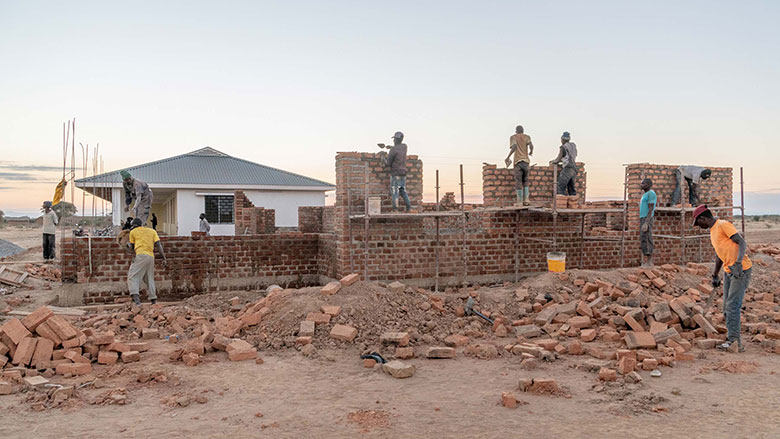Challenge
One of Tanzania’s greatest long-term developmental challenges has been providing citizens with access to decent and affordable housing. While it’s been a government priority, interventions had limited success before 2010, even with a rapid urbanization and an increased demand for affordable housing and housing finance, especially by the lower and middle-income segments of the population. The lack of access to affordable housing impacted people’s well-being, including: safety, hygiene and health issues (lack of access to clean water, safe toilets, dust in the house and extreme heat); preventable illness (malaria or dengue); and access to basic needs of living, such as electricity which also impacted education and access to information. Often, the lower and middle-income population had no option but to save money to gradually build their own houses over several years, sometimes decades, while they rented or lived in poor or unfinished houses.
Approach
The Tanzania Housing Finance Project demonstrates the best of the World Bank’s innovation and risk-taking during project design and implementation, reflecting principles of Maximizing Finance for Development. To expand the housing finance market, the Tanzania Mortgage Refinance Company (TMRC) was created to provide medium-and-long-term liquidity to mortgage lenders. A Housing Microfinance Fund was also created to provide medium-term liquidity to microfinance institutions, offering housing microfinance loans to the low-income population. To ensure financial viability and sustainability of the TMRC beyond the project period, the World Bank helped design its access to capital markets through bond issuances. The project showed that private capital, even in less-developed financial markets, can be mobilized successfully through judicious public investments in relatively large volumes, compared to overall credit market size. Through two extensions, two restructurings, and additional financing, the World Bank stayed with the project for nearly 10 years.
Results
The Tanzania Housing Finance Project was the first of its kind in Sub-Saharan Africa, involving risk-taking and innovation on the part of the World Bank and the client. A seven-fold expansion of the housing finance market was achieved, and long-term sustainability of the mortgage market was ensured through market-based products.
- Mortgages for new housing and renovation/remodeling expanded under the project, from TZS 77 billion in 2011 to TZS 508 billion in 2018.
- The market for commercial housing microfinance reached TZS 30 billion (from almost non-existent) within four years.
- Five thousand mortgages and two thousand housing micro-finance loans were provided. Nearly 34 percent of the beneficiaries were women (including joint ownership).
- At the time of the closing of the project in 2019, 33 financial institutions were providing mortgages to consumers, as compared to four in 2010.
- The expanding market (along with favorable macroeconomic developments) has brought down interest rates from above 21 percent to 15 percent per year.
- Mortgage tenors have increased from a maximum of 10–15 years to 25–30 years and longer duration fixed-rate loans are now available. The TMRC, which anchors the development of the mortgage market, is fully owned and operated by the private sector.
- The Housing Microfinance Fund makes housing finance accessible to lower income segments of the population that mostly engage in incremental construction (renovation/remodeling) of their homes.
- Appropriate financial products targeting the lower income segments (smaller scale specialized loans for improving and/or expanding houses) were developed in partnership with microfinance institutions and banks. The project provided the opportunity to test and develop a commercially viable approach of offering housing microfinance loans to the lower income segments. This has also demonstrated sustainability of developing housing microfinance market even after the project ended.
World Bank Group Contribution
The Tanzania Housing Finance Project was an IDA $100 million investment lending operation. It was originally approved with $40 million in 2010 and with $60 million in additional financing in 2015. The project was disbursed almost entirely at closing in June 2019. Recognizing the project’s success, the International Finance Corporation has invested up to $12 million in the TMRC on their equity and bond and to provide the advisory services.
Partners
The $100 million IDA credit to the government of Tanzania was implemented by the Bank of Tanzania (BoT: Central Bank of Tanzania) in strong partnerships with the Ministry of Finance and Planning, and the Ministry of Lands, Housing and Human Settlements Development. TMRC, the wholesale mortgage finance company created under the project, played the critical role in developing the mortgage market in Tanzania along with their shareholders (banks) and other partners.
Moving Forward
The Tanzania Housing Finance Project has significantly contributed to the establishment and development of the housing finance market in Tanzania. TMRC started accessing the capital market through bond issuances during the last few years to ensure the financial sustainability of private capital. However, significant housing needs remains, which will require further expansion of the affordable housing finance market.
Beneficiaries
During the project period (2010 – 2019), 5,000 mortgages and 2,000 housing micro-finance loans were provided. Nearly 34 percent of the beneficiaries were women (including joint ownership). The number of beneficiaries is expected to increase as TMRC continues playing the catalytic role of expanding the housing finance in the country along with banks and microfinance institutions.
